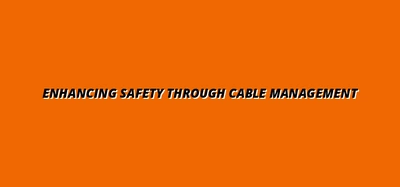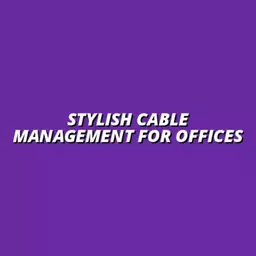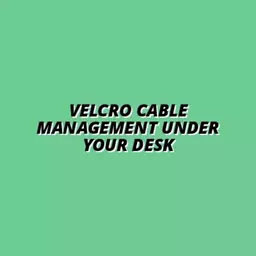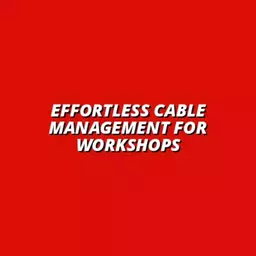Reduction in Workplace Incidents
Well-organized cables can reduce accidents by up to 40%.

Effective cable management is not just about aesthetics; it’s a fundamental aspect of workplace safety that can significantly reduce hazards and improve efficiency. As businesses strive for enhanced safety and productivity, understanding and implementing strong cable management practices becomes crucial.
Investing in efficient cable management not only enhances workplace safety but also leads to significant operational benefits. Below are key statistics showcasing this impact:
Well-organized cables can reduce accidents by up to 40%.
Fewer accidents lead to lower insurance costs.
Less time spent on dealing with accidents means more productivity.
A safe workplace boosts confidence and job satisfaction.
When it comes to maintaining a safe and efficient workspace, effective cable management plays a crucial role. Unorganized cables can lead to numerous hazards that not only disrupt productivity but can also pose serious safety risks. Think about it: tangled cables can create trip hazards, contribute to electrical dangers, and even increase the likelihood of fires. At Power Tidy Workspace Lab, we understand these risks and strive to help businesses implement safe and efficient under-desk power solutions.
It's essential to recognize the common hazards that arise from cluttered cables. Here are a few key issues to consider:
By identifying these hazards early, organizations can take proactive measures to improve their workspace safety. After all, a tidy workspace isn't just about aesthetics; it's about creating an environment where employees feel secure and productive.
Tangled cables are a leading cause of workplace accidents. The last thing you want is for an employee to trip while navigating their workspace. To avoid these hazards, consider implementing the following tips:
By taking these simple steps, you can reduce the likelihood of trips and falls, contributing to a safer work environment. Just imagine walking through a workspace where cables are neatly tucked away—much more inviting, right? For more information on the right accessories to use, consider reading our article on essential cable management tools.
Exposed or improperly managed electrical cables can be more than an eyesore; they're a significant safety concern. These cables can become damaged, leading to electrical shorts or even fires. To minimize this risk, it's crucial to:
Addressing these issues proactively not only safeguards your employees but also ensures compliance with safety standards. Remember, safety should always come first, especially in the workplace!
Poor cable organization can lead to overheating situations, particularly in environments filled with electronic equipment. In IT-related areas, where devices are abundant, the risk is even higher. To enhance fire safety, consider these practices:
💡 Mounting power strips safely and cleanly? Get our guide to under-desk power that’s neat and safe. 👉 Read the Under-Desk Power Guide
By prioritizing cable management, you're not just enhancing safety but also helping to create a more efficient workspace. At Power Tidy Workspace Lab, we believe that a safe setup leads to increased productivity!
It's important to adhere to relevant safety standards that govern cable management practices in the workplace. Key regulations include:
By following these regulations, businesses can mitigate risks and ensure a safe working environment. Compliance isn't just about avoiding fines; it's about fostering a culture of safety and reliability within your organization.
Effective cable management doesn't just improve safety; it also boosts operational efficiency. When cables are organized:
By investing in proper cable management solutions, like those offered by Power Tidy Workspace Lab, you're taking a step towards a more productive environment. It pays off in the long run!
Cable management also involves considering ergonomics—how we handle and install cables can impact our physical health. To reduce strain, keep these tips in mind:
By mindful handling of cables, you can help prevent injuries and promote a healthier working environment. And let's not forget, your team will appreciate the thoughtfulness!
There are numerous tools available to help maintain an organized workspace. Here are some of my favorites:
These tools not only simplify cable management but also ensure that safety remains a top priority. Investing in quality products can make a world of difference in your workspace! For a budget-friendly option, make sure to check out our guide on budget cable management solutions for a tidy workspace.
Let me share a few success stories that demonstrate the positive impact of effective cable management:
These examples highlight how prioritizing cable organization can lead to tangible benefits. As we continue to promote safety and efficiency at Power Tidy Workspace Lab, I hope you feel inspired to examine your own workspace organization!
Here's a brief recap of the key points discussed so far:
In today's fast-paced work environments, effective cable management is more than just an organizational task—it's a vital aspect of workplace safety. By keeping cables tidy, we can significantly reduce hazards and maintain compliance with safety regulations. Think about it: a well-managed workspace not only looks better but also fosters a safer atmosphere for everyone. That’s why at Power Tidy Workspace Lab, we emphasize the importance of investing in high-quality cable management solutions!
Moreover, with the right strategies in place, businesses can create a workspace that enhances productivity while ensuring employees feel secure. Remember, safety isn’t just about compliance; it’s about creating an environment where everyone can perform at their best without unnecessary risk. Let's dive into the quantifiable benefits of organized cable management!
Did you know that workplaces that implement effective cable management strategies can see a significant drop in workplace incidents? Research indicates that well-organized cables can reduce accidents by up to 40%! When we consider the potential financial and human costs of accidents, investing in cable management becomes a no-brainer.
At Power Tidy Workspace Lab, we understand that investing in effective solutions not only protects your employees but also pays off in the long run. Think of it as an upfront investment in your team's safety and well-being!
As technology evolves, so do the tools for cable management! Innovative solutions are now available to make cable organization easier and more efficient. Consider the following advancements:
By incorporating these cutting-edge technologies into your workspace, you can not only enhance safety but also streamline operations. It's all about making your environment work for you!
Did you know that the design of your workspace can significantly impact how well cables are managed? Thoughtful layouts can create natural pathways for cables, minimizing clutter and enhancing safety. Here are a few design tips to consider:
By integrating cable management into your workspace design, you not only improve aesthetics but also contribute to a safer work environment. At Power Tidy Workspace Lab, we believe that a tidy workspace reflects a productive mindset! Speaking of workspace design, consider checking out tips on organizing cables for your desk for a more streamlined setup.
Last but not least, one of the best ways to ensure effective cable management is through employee training. Providing staff with the knowledge and tools to manage cables properly can significantly reduce risks. Consider implementing:
By investing in training, you empower your employees to contribute to a safer work environment. It’s a win-win for everyone involved!
Do you have questions about cable management? You're not alone! Here are some common inquiries that might help:
Addressing these questions not only enhances understanding but also encourages a culture of safety within your organization. Remember, effective cable management is a journey, not a destination!
Here is a quick recap of the important points discussed in the article:
Stylish Cable Management for Offices

Have you ever found yourself untangling a mess of cords in your workspace? The impact of chaotic cab
Velcro Cable Management Under Your Desk

Taking control of your workspace can dramatically enhance your productivity and focus. Did you know
Effortless Cable Management for Workshops

Have you ever stepped into a chaotic workspace, where tangled cords hitch a ride on your productivit
Stylish Cable Management for Offices
Velcro Cable Management Under Your Desk
Effortless Cable Management for Workshops
Everyday Cable Management Tips
Improve Office Productivity: Cable Tips